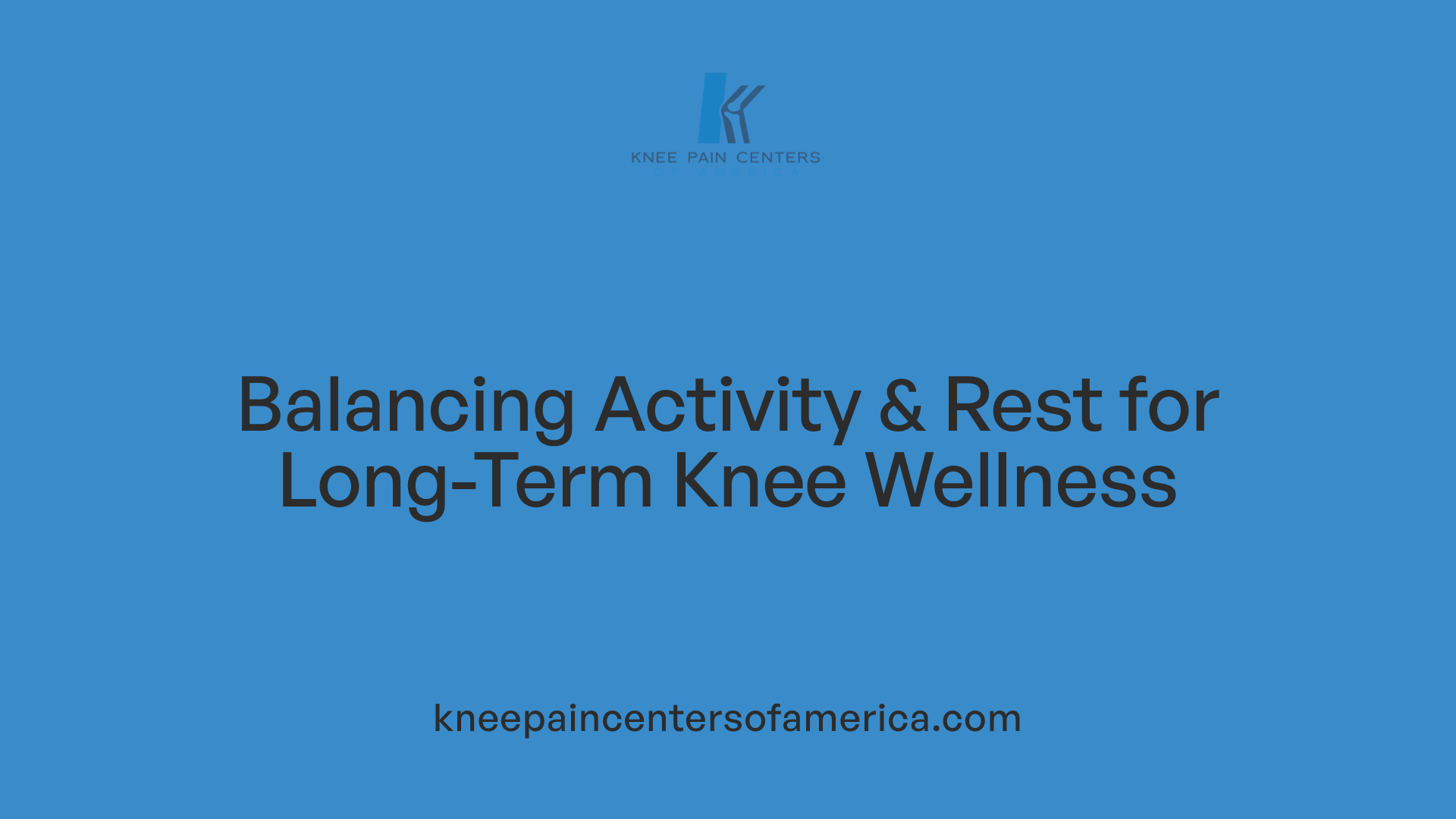Understanding Passive Range of Motion Exercises for the Knee
Knee osteoarthritis and injury often lead to pain, stiffness, and limited mobility, profoundly impacting daily function. Passive range of motion (ROM) exercises play a crucial role in restoring knee function, especially in early rehabilitation stages or when joint movement is restricted. This article explores the significance of passive ROM exercises in knee health, their place alongside other medical and non-surgical treatments, and emerging therapies aiming to improve outcomes for patients with knee pain due to osteoarthritis or injury.
What Are Passive Range of Motion Exercises and Their Benefits for the Knee?

Definition of passive range of motion exercises
Passive range of motion (ROM) exercises involve a therapist or a mechanical device moving the knee joint through its natural range without any effort from the patient. This form of exercise helps to gently mobilize the joint, aiding recovery without placing strain on the muscles or tissues.
How passive ROM exercises restore knee mobility
By promoting gentle, controlled movement of the knee joint, these exercises help restore mobility following injury or surgery. Stimulating joint motion through passive movement assists in maintaining lubrication and flexibility, reducing stiffness and pain often associated with osteoarthritis and immobility.
Exercise examples and recommended techniques
Passive knee extension exercises can be performed by sitting on a firm surface and placing a soft object under the heel, allowing gravity to aid the leg’s straightening for about 5 minutes. For knee flexion, a towel or strap looped around the foot gently pulls the knee toward the buttocks to increase bend, also for around 5 minutes. These exercises should be done cautiously, keeping pain below a mild intensity (no more than 3 out of 10 on the pain scale).
Suitability for osteoarthritis and post-surgical recovery
Passive ROM exercises are particularly beneficial during early recovery stages after surgery such as meniscus repair or injury. They support patients with knee osteoarthritis by enhancing joint movement without overtaxing weakened muscles. Patients are advised to consult their surgeon or physiotherapist regarding specific movement limits, such as avoiding knee flexion beyond 90 degrees for several weeks when required.
Precautions and pain management during exercises
Avoiding pain beyond a mild level is crucial during passive ROM exercises to prevent injury or overexertion. If pain increases or persists, exercises should be scaled back or halted and professional advice sought. Consistent guidance from healthcare providers ensures safe and effective rehabilitation tailored to individual recovery needs.
How do non-surgical interventions help manage osteoarthritis-related knee pain?
Non-surgical approaches, including passive ROM exercises, reduce inflammation and improve joint function while strengthening surrounding muscles. These interventions collectively help ease osteoarthritis symptoms by enhancing stability and flexibility, contributing to better overall knee health and mobility.
Incorporating Passive ROM into a Comprehensive Knee Rehabilitation Program

Role of passive ROM alongside active exercises
Passive range of motion (ROM) exercises are essential during early knee rehabilitation, especially post-injury or surgery. They involve external assistance—such as from a therapist or device—to move the joint gently, helping restore flexibility without straining the muscles. These exercises complement active and active-assistive exercises, where the patient participates more in moving the joint. Together, they work to improve mobility while avoiding pain or injury.
Importance of muscle strengthening and stretching exercises
Muscle strengthening around the knee, including quadriceps sets, straight leg raises, and heel raises, supports weak joints and enhances stability, reducing stress on the joint. Stretching exercises that target the hamstrings, quadriceps, and calf muscles improve flexibility and joint range of motion, crucial for managing pain and preventing further injury in osteoarthritis patients.
Typical rehabilitation timeline and progression
A structured rehabilitation program usually spans 4 to 6 weeks. Initially, exercises focus on gentle passive and active-assisted movements, gradually progressing to active strengthening and flexibility routines. The progression incorporates resistance tools such as ankle weights and resistance bands to safely increase muscle strength and endurance.
Use of warm-up activities before exercises
Preparing the knee for exercise through low-impact warm-ups like walking or stationary cycling helps increase blood flow and loosen muscles, reducing injury risk during the main exercise sessions.
Guidelines for repetitions and exercise frequency
Exercise regimens recommend 10 to 20 repetitions of each movement, performed 3 to 4 times daily for ROM exercises. Strength training exercises are usually performed 2 to 5 times a week under professional guidance to ensure safety. Stretching exercises should be held for 20 to 30 seconds and repeated 2 to 3 times daily to maintain flexibility.
These combined approaches comprise some of the most effective strategies for managing knee pain caused by osteoarthritis, melding passive and active therapies into a comprehensive and progressive recovery program.
The Role of Injections and Emerging Treatments in Supporting Exercise-Based Knee Care

What role do injections play in the treatment of knee osteoarthritis?
Injections such as corticosteroids and hyaluronic acid are commonly used to manage knee osteoarthritis symptoms by reducing inflammation and easing pain within the joint. This targeted relief allows patients a better opportunity to participate in exercise therapy, including passive range-of-motion (ROM) exercises, without excessive discomfort.
How are injections integrated with exercise therapy?
By decreasing pain and swelling, injections create a therapeutic window where patients can engage more effectively in rehabilitation exercises. This integration supports improved joint mobility and muscle strength, helping to slow disease progression and improve function.
What emerging therapies complement traditional treatments?
Emerging intra-articular treatments include platelet-rich plasma (PRP) and stem cell therapies, which focus on promoting tissue repair and regeneration. Additionally, knee embolization—a minimally invasive procedure designed to reduce joint inflammation and pain—is gaining attention. These innovative approaches aim to support the biological environment of the joint, making exercise-based rehabilitation more effective and sustainable.
How do these treatments complement passive ROM and physical therapy?
When combined with passive ROM and structured physical therapy, these injection-based therapies enhance the overall treatment strategy by alleviating symptoms and improving the physiological condition of knee tissues. This synergistic effect facilitates greater participation in strengthening and flexibility exercises, ultimately leading to better knee health and function.
| Treatment Type |
Purpose |
Role in Exercise Rehabilitation |
| Corticosteroid Injections |
Reduce inflammation and pain |
Allow more comfortable participation in exercise therapy |
| Hyaluronic Acid Injections |
Provide joint lubrication and pain relief |
Enhance joint mobility for better exercise tolerance |
| Platelet-Rich Plasma (PRP) |
Promote tissue healing and regeneration |
Support long-term joint health improving rehab outcomes |
| Stem Cell Therapy |
Stimulate cartilage repair |
Potentially restore joint environment, complementing exercise |
| Knee Embolization |
Minimize blood flow to inflamed areas, reducing pain |
Facilitate engagement in physical therapy by symptom relief |
When Is Surgery Recommended and How Does Passive ROM Fit in Post-Operative Care?

When is knee replacement surgery considered a suitable option for osteoarthritis patients?
Knee replacement surgery is typically recommended when osteoarthritis causes severe pain and significant loss of function that cannot be effectively managed through conservative treatments. These include medications, weight management, and exercise programs aimed at strengthening muscles and improving joint mobility.
Importance of conservative treatments before surgery
Before opting for surgery, patients are encouraged to try non-surgical approaches such as range of motion and strengthening exercises. These strategies can help reduce pain, improve mobility, and delay or sometimes eliminate the need for surgery.
Using passive ROM exercises after surgery to restore mobility
After knee replacement or other surgical interventions, passive range of motion (ROM) exercises become crucial in post-operative care. Passive exercises involve the joint being moved with the help of a therapist or a device, promoting gentle movement without active muscle use. This helps prevent joint stiffness, maintains flexibility, and supports circulation as the healing process begins.
Post-operative precautions and surgeon guidelines
Surgeons usually provide specific recommendations regarding the degree of motion allowed after surgery, such as avoiding knee flexion beyond 90 degrees for a certain period following meniscus repair. It is vital to respect these limitations to avoid compromising the surgical repair.
Role of physiotherapists in guided rehabilitation
Physiotherapists play a key role in developing and supervising rehabilitation plans. They ensure exercises are performed safely, optimize recovery, and help patients progressively improve strength and flexibility. Regular sessions with professionals guide patients through passive, active-assistive, and active ROM exercises tailored to their recovery stage.
| Aspect |
Description |
Importance in Post-Operative Care |
| Indications for Surgery |
Severe, unmanageable pain and functional impairment |
When conservative measures are insufficient |
| Conservative Treatments |
Exercise, medication, weight management |
Delay or avoid surgery; improve outcomes |
| Passive ROM Exercises |
Therapist-assisted joint movement |
Prevent stiffness; protect surgical repairs |
| Post-Op Precautions |
Following surgeon's motion limits |
Avoid damage to the surgical site |
| Physiotherapist Involvement |
Supervised rehabilitation programs |
Safe progression; personalized recovery plans |
Balancing Activity and Rest: Practical Guidance for Long-Term Knee Health

Why is consistency in exercise important for knee osteoarthritis?
Consistency in gentle exercise, including passive range of motion (ROM) exercises, is crucial for maintaining joint mobility and reducing pain and stiffness associated with knee osteoarthritis. Performing these exercises daily—aiming for about 30 minutes—helps improve physical function and supports long-term joint health.
What daily activities are recommended for osteoarthritis patients?
Walking and cycling are encouraged as beneficial, low-impact activities that complement targeted ROM exercises. Including exercises such as heel slides, knee bends, and leg strengthening routines several times a week promotes muscle support around the knee.
How can walking, cycling, and low-impact exercises be combined with ROM tasks?
A balanced routine might start with light warm-up activities like stationary cycling or walking for 5–10 minutes, followed by ROM exercises (such as knee extensions and flexions) and muscle strengthening tasks (like straight leg raises and step-ups). This combination enhances joint flexibility and muscle strength, reducing stress on the knee joint.
How should patients monitor pain and avoid overexertion?
Exercises should be done within a pain-free range, generally keeping discomfort below 3 to 5 on a 10-point scale. If pain worsens or sharp sensations occur, it’s important to stop and rest. Excessive rest can delay recovery, so finding the right balance is essential.
When should professional medical care be sought?
If knee pain lasts beyond a few weeks, the knee locks or gives way, or if severe pain develops, consulting a healthcare provider is advised. Regular check-ins help tailor exercise regimens safely and incorporate emerging treatments if needed.
Emerging medical treatments alongside this balanced approach aim to manage osteoarthritis effectively. Prioritizing gradual, consistent activity supported by professional guidance empowers patients to maintain knee function and quality of life over time.
Integrating Passive ROM Exercises into Holistic Knee Osteoarthritis Care
Passive range of motion exercises represent a foundational element in the management of knee osteoarthritis and recovery from injury or surgery. When combined with active strengthening, stretching, pharmacologic treatments, and emerging therapies, they contribute to improved joint mobility, reduced pain, and enhanced quality of life. Careful adherence to professional guidance, gradual progression, and balance between activity and rest are key for safe and effective rehabilitation. As research continues to advance, these gentle yet essential exercises remain central to optimizing knee health for patients at all stages of osteoarthritis.
References